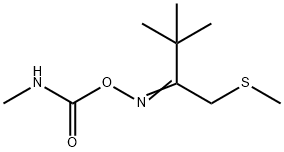3,3-Dimethyl-1-(methylthio)buta-non-O-(N-methyl-carbamoyl)oxim
|
|
3,3-Dimethyl-1-(methylthio)buta-non-O-(N-methyl-carbamoyl)oxim Eigenschaften
- Schmelzpunkt:
- 57℃
- Dichte
- 1.1664 (rough estimate)
- Dampfdruck
- 2.3×10-2 Pa (25 °C)
- Brechungsindex
- 1.6800 (estimate)
- Flammpunkt:
- >100 °C
- storage temp.
- 0-6°C
- Wasserl?slichkeit
- 5.2 g 1 l-1 (22 °C)
- pka
- 13.82±0.46(Predicted)
- EPA chemische Informationen
- Thiofanox (39196-18-4)
Sicherheit
- Risiko- und Sicherheitserkl?rung
- Gefahreninformationscode (GHS)
| Kennzeichnung gef?hrlicher | T+,N | ||
|---|---|---|---|
| R-S?tze: | 27/28-50/53 | ||
| S-S?tze: | 27-36/37-45-60-61 | ||
| RIDADR | 2757 | ||
| WGK Germany | 3 | ||
| RTECS-Nr. | EL8200000 | ||
| HazardClass | 6.1(a) | ||
| PackingGroup | II | ||
| HS Code | 29309090 | ||
| Giftige Stoffe Daten | 39196-18-4(Hazardous Substances Data) |
| Bildanzeige (GHS) |
 
|
||||||||||||||
|---|---|---|---|---|---|---|---|---|---|---|---|---|---|---|---|
| Alarmwort | Achtung | ||||||||||||||
| Gefahrenhinweise |
|
||||||||||||||
| Sicherheit |
|
3,3-Dimethyl-1-(methylthio)buta-non-O-(N-methyl-carbamoyl)oxim Chemische Eigenschaften,Einsatz,Produktion Methoden
R-S?tze Betriebsanweisung:
R27/28:Sehr giftig bei Berührung mit der Haut und beim Verschlucken.R50/53:Sehr giftig für Wasserorganismen, kann in Gew?ssern l?ngerfristig sch?dliche Wirkungen haben.
S-S?tze Betriebsanweisung:
S27:Beschmutzte, getr?nkte Kleidung sofort ausziehen.S36/37:Bei der Arbeit geeignete Schutzhandschuhe und Schutzkleidung tragen.
S45:Bei Unfall oder Unwohlsein sofort Arzt zuziehen (wenn m?glich, dieses Etikett vorzeigen).
S60:Dieses Produkt und sein Beh?lter sind als gef?hrlicher Abfall zu entsorgen.
S61:Freisetzung in die Umwelt vermeiden. Besondere Anweisungen einholen/Sicherheitsdatenblatt zu Rate ziehen.
Chemische Eigenschaften
Thiofanox is a colorless solid with a pungent odor.Verwenden
Thiofanox is a systemic soil insecticide used for the control of aphids, mites, thrips, plant bugs, leafhoppers and beetles in/on sugar beet and potatoes.Allgemeine Beschreibung
THIOFANOX is a colorless solid with a pungent odor. Used as a systemic insecticide and acaricide.Air & Water Reaktionen
Thio and dithiocarbamates slowly decompose in aqueous solution to form carbon disulfide and methylamine or other amines. Such decompositions are accelerated by acids.Reaktivit?t anzeigen
THIOFANOX is a thiocarbamate. Flammable gases are generated by the combination of thiocarbamates and dithiocarbamates with aldehydes, nitrides, and hydrides. Thiocarbamates and dithiocarbamates are incompatible with acids, peroxides, and acid halides.Health Hazard
THIOFANOX is a carbamate pesticide. Carbamate pesticides are moderately to highly toxic. It is a cholinesterase inhibitor.Brandgefahr
(Non-Specific -- Carbamate Pesticide, Solid, n.o.s.) Container may explode in heat of fire. When heated to decomposition, THIOFANOX emits very toxic fumes of nitrogen and sulfur oxides. Stable at normal storage temperature; reasonably stable to hydrolysis at less than 86F at pH 5-9.Pharmakologie
The insecticidal carbamates are cholinergic. Poisoned insects and animals exhibit violent convulsions and other neuromuscular disturbances. These insecticides carbamylate acetylcholinesterase and may have a direct action on acetylcholine receptors. The mechanism of interaction with acetylcholinesterase is analogous to the normal three-step hydrolysis of acetylcholine. However, the third reaction step is much slower for the carbamylated enzyme than for the acetylated one. The importance of structural complementarity of the insecticidal carbamates to the active site of acetylcholinesterase is demonstrated by the pronounced difference in activities of D-2-(sec-butylphenyl) methylcarbamate and L-2-(sec-butylphenyl) methylcarbamate (the L isomer is five times more toxic) and of the 2-, 3-, and 4-substituted phenylmethylcarbamates, where the 4-isomers are virtually inactive.Detoxification of carbamate insecticides occurs in vivo through microsomal hydroxylation, N-demethylation of carbamyl nitrogen, side chain oxidation, and ring hydroxylation. Methylenedioxyphenyl synergists prevent oxidation
m?gliche Exposition
A potential danger to those involved in the manufacture, formulation and application of this thiocarbamate systemic insecticide and acaricide.Stoffwechselwegen
The hydrolytic degradation and metabolism of thiofanox in soils, plants and animals follow a common pathway. Oxidation of the S-methyl moiety is the primary reaction to yield the thiofanox sulfoxide and sulfone. Hydrolysis of the carbamate linkage to yield the oximes is only a minor pathway for thiofanox and its oxidation products (Scheme 1).Versand/Shipping
UN2757 Carbamate pesticides, solid, toxic, Hazard Class: 6.1; Labels: 6.1-Poisonous materials. UN2811 Toxic solids, organic, n.o.s., Hazard Class: 6.1; Labels: 6.1-Poisonous materials, Technical Name Required.Inkompatibilit?ten
Thiocarbamate esters are combustible. They react violently with powerful oxidizers such as calcium hypochlorite. Poisonous gases are generated by the thermal decomposition of thiocarbamate compounds, including carbon disulfide, oxides of sulfur, oxides of nitrogen, hydrogen sulfide, ammonia, and methylamine. Many materials in this group slowly decompose in aqueous solution to form carbon disulfide and methylamine or other amines. Such decompositions are accelerated by acids. Flammable gases are generated by the combination ofWaste disposal
In accordance with 40CFR 165 recommendations for the disposal of pesticides and pesticide containers. Must be disposed properly by following package label directions or by contacting your local or federal environmental control agency, or by contacting your regional EPA office. Consult with environmental regulatory agencies for guidance on acceptable disposal practices. Generators of waste containing this contaminant (≥100 kg/mo) must conform with EPA regulations governing storage, transportation, treatment, and waste disposal.3,3-Dimethyl-1-(methylthio)buta-non-O-(N-methyl-carbamoyl)oxim Upstream-Materialien And Downstream Produkte
Upstream-Materialien
Downstream Produkte
39196-18-4(3,3-Dimethyl-1-(methylthio)buta-non-O-(N-methyl-carbamoyl)oxim)Verwandte Suche:
- (2Z)-3,3-Dimethyl-2-(([(methylamino)carbonyl]oxy)imino)-1-(methylsulfanyl)butane
- 1-(2,2-dimethyl-1-methylthiomethylpropylideneamino-oxy)-n-methylformamide
- 2-Butanone, 3,3-dimethyl-1-(methylthio)-, O-*(methylamino)carbonyl
- 2-Butanone, 3,3-dimethyl-1-(methylthio)-, O-[(methylamino)carbonyl]oxime
- 3,3-Dimethyl-1-(Methylthio)-2-butanone O-[(methylamino)carbonyl]oxime
- 3,3-dimethyl-1-(methylthio)-2-butanone-o-((methylamino)carbonyl)oxime
- 3,3-dimethyl-1-(methylthio)-2-butanono-((methylamino)carbonyl)oxime
- 3,3-dimethyl-1-(methylthio)-2-butanono-[(methylamino)carbonyl]oxime
- 3,3-dimethyl-1-(methylthio)butanone-o-(n-methylcarbamoyl)oxime
- 3,3-dimethyl-1-(methylthio)-O-[(methylamino)carbonyl]-2-butanoneoxime
- benelux
- caswellno.368bb
- Diamond shamrock ds-15647
- diamondshamrockds-15647
- DS 15647
- ds-15647
- ENT 27851
- ent27851
- pesticidecodeno.10920
- Rcra waste number P045
- 3,3-DIMETHYL-1-(METHYL THIO)BUTANONE O-METHYL CARBAMOYLOXIME
- THIOFANOX
- rcrawastenumberp045
- Thiofanocarb
- thiofanox0
- DACAMOX
- THIOFANOX PESTANAL, 250 MG
- THIOFANOX STANDARD
- Thiolanox
- 3,3-dimethyl-1-(methylthio)butanone-O-(N-methylcarbamoyl)oxime thiofanox
- 3,3-Dimethyl-1-(methylthio)-2-butanone O-(methylcarbamoyl)oxime
- AGBTZYDUBVIKEZ-YRNVUSSQSA-N
- Thiofanox Solution
- Thiofanox solution in methanol, 100ppm
- Thiofanox Solution in Acetonitrile, 1000μg/mL
- Thiofanox in Metahnol
- 39196-18-4
- AcaricidesPesticides
- Alpha sort
- CarbamatesPesticides&Metabolites
- Insecticides
- Pesticides
- Pesticides&Metabolites
- Q-ZAlphabetic
- TF - TO







